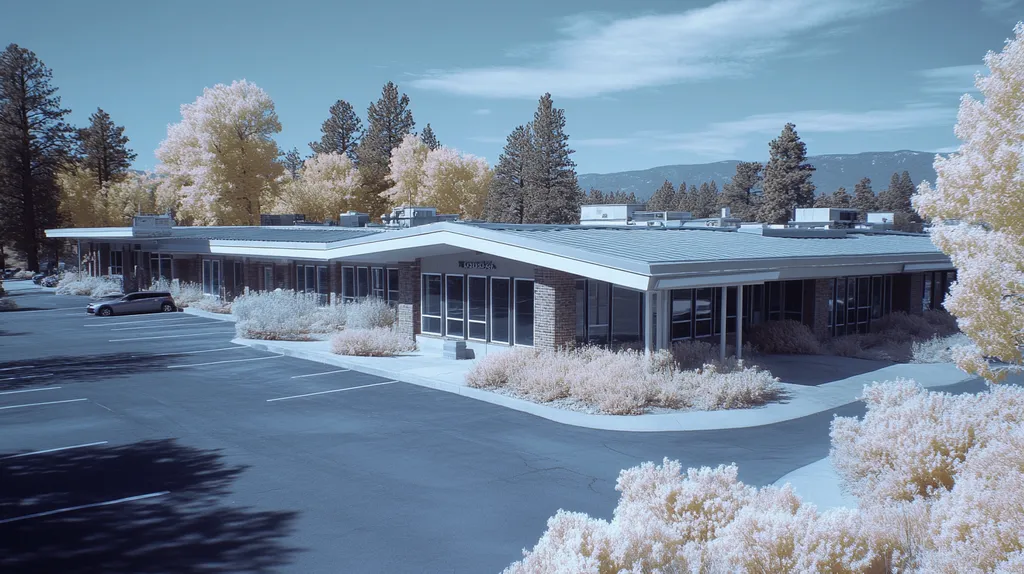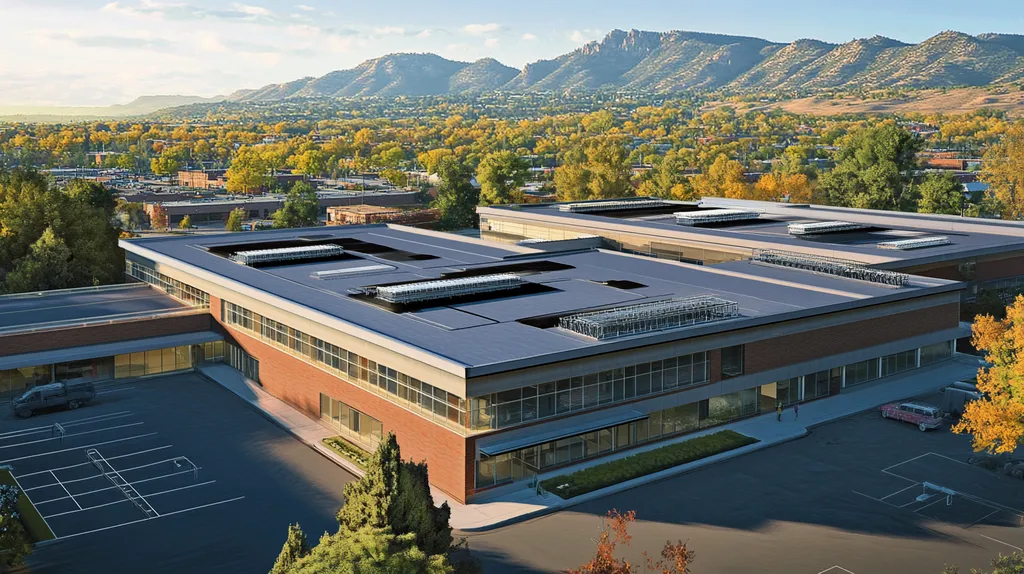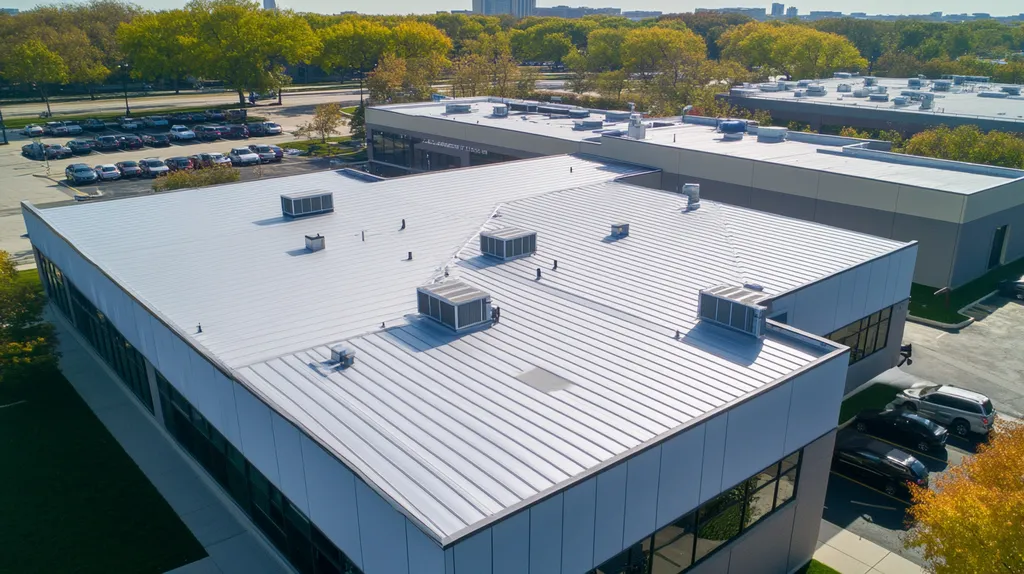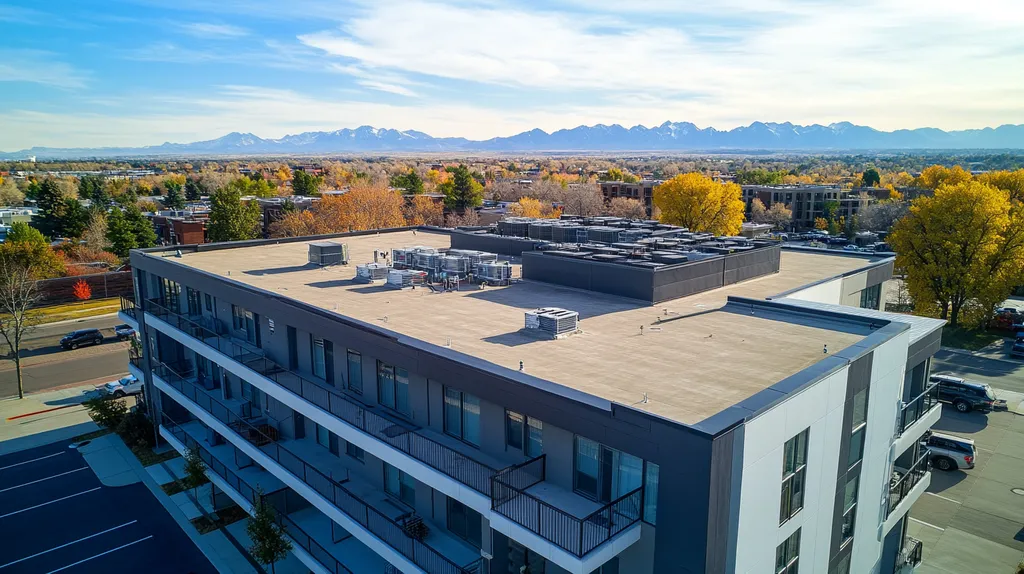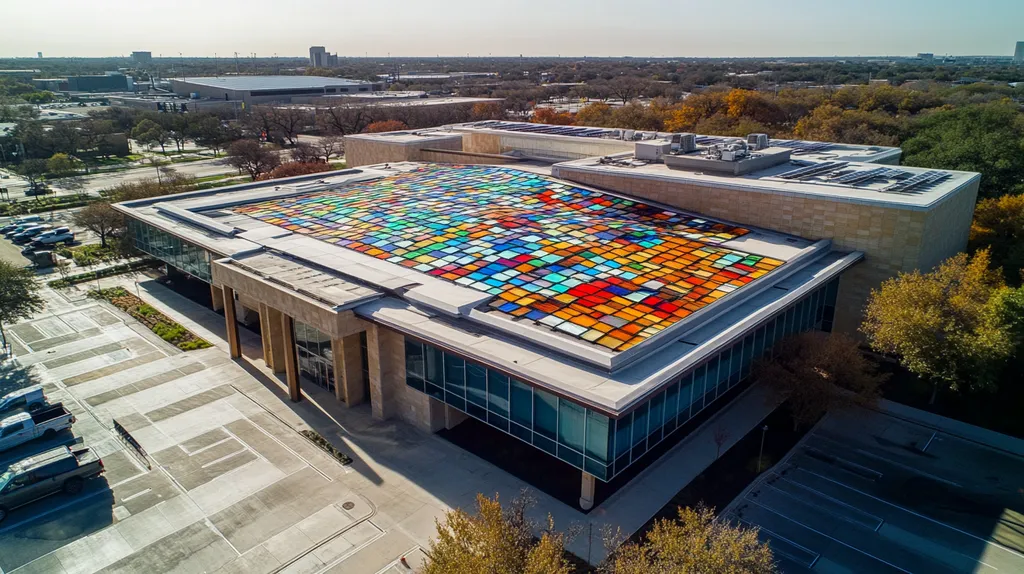Every day, commercial roofs silently shield millions in business assets while battling UV rays, moisture, and temperature extremes. Yet studies show over 80% of industrial roofs fail prematurely due to inadequate maintenance.
For facility managers, knowing when and how to maintain their roofing systems isn’t just about preventing leaks – it’s about protecting critical operations and avoiding costly emergency repairs.
This comprehensive guide breaks down the essential factors in roof maintenance, from identifying early warning signs to implementing preventive strategies that extend your roof’s lifespan and maximize your return on investment.
SECTION 1: THE BASICS EXPLAINED
Think of your commercial roof as a faithful guardian working 24/7 to protect your business investment. While it quietly battles UV rays, rain, snow, and whatever else Mother Nature throws its way, it needs regular care to keep performing at its best. Unfortunately, many building owners only think about their roofs when something goes wrong – and by then, small issues have often snowballed into budget-busting problems.
What It Is (In Plain Language)
Roof maintenance is like giving your building’s shield a regular health check-up. Just as you wouldn’t skip your annual physical, your roof needs routine attention to stay in fighting shape.
These check-ups include hunting down sneaky leaks before they become waterfall features in your facility, making sure all those rooftop components are playing nice together, and giving drainage systems a clear path to do their job.
It’s also about catching and fixing the small stuff – like loose flashings or tiny punctures – before they invite bigger problems to the party. Think of it as preventive medicine for your building’s most important protective layer.
Most importantly, it’s about being proactive rather than reactive, because emergency roof repairs are about as much fun as a surprise root canal – and usually just as expensive.
Why It Matters (To Your Building)
Your roof isn’t just keeping the weather out – it’s protecting everything that makes your business tick. From inventory and equipment to employees and customers, a failing roof can put it all at risk.
A well-maintained roof is also your building’s top energy efficiency performer. It keeps heated or cooled air where it belongs, rather than letting your HVAC system work overtime trying to heat or cool the great outdoors.
Regular maintenance helps you dodge those middle-of-the-night emergency calls about leaks during a storm. It’s also your insurance company’s best friend, often leading to lower premiums and fewer claim hassles.
Beyond protecting your wallet, proper maintenance extends your roof’s lifespan by years – sometimes decades. That’s not just good business sense; it’s smart environmental stewardship too.
How It Works
Picture roof maintenance as a three-act play: Inspect, Plan, and Act. The inspection is like a treasure hunt, where trained professionals search for hidden problems before they become obvious (and expensive) ones.
The planning stage is where priorities get sorted – kind of like triaging in an emergency room. Critical issues jump to the front of the line, while less urgent matters get scheduled for future attention.
The action phase brings in the specialists with their tools and expertise. Sometimes it’s as simple as patching a small tear; other times, it might involve replacing sections of the roof system.
Throughout the process, detailed records are kept – because when it comes to roof maintenance, good documentation is worth its weight in gold. These records become your roof’s medical history, helping track patterns and predict future needs.
SECTION 2: PRACTICAL APPLICATIONS
Think of your industrial roof as a complex symphony where every component needs to play in perfect harmony. When one instrument goes out of tune – say, a loose fastener or cracked seam – the whole performance suffers. And just like a neglected instrument, an ignored roof will eventually hit some very expensive wrong notes.
Unfortunately, too many facility managers wait until they hear that metaphorical screeching violin – usually in the form of a ceiling drip during an important client meeting – before taking action. Let’s explore how to keep your roof performing at Carnegie Hall levels instead of amateur night.
Common Uses & Examples
Your industrial roof isn’t just a fancy umbrella – it’s a sophisticated system that works harder than a caffeinated accountant during tax season. From keeping your temperature-sensitive inventory safe to protecting million-dollar equipment, it’s the unsung hero of your operation.
Different roofing types have their superpower specialties. Membrane roofs are like the yoga masters of the roofing world – flexible, lightweight, and excellent at keeping water out. Metal roofs are the heavyweight champions, perfect for facilities that need industrial-strength protection.
Even the most robust roof systems need regular attention. Those seemingly minor surface scratches or loose fasteners are like tiny cracks in a dam – ignore them, and you might find yourself hosting an impromptu indoor swimming pool.
Good maintenance practices can dramatically boost your building’s energy performance and should be viewed as a valuable resource. Regular inspections and upkeep don’t just prevent leaks – they’re like giving your building a built-in savings account. (source: Pacific Northwest National Laboratory)
When You Need It Most
Timing is everything in roof maintenance, just like hitting the beach – you wouldn’t go during a hurricane, right? Spring and fall are your golden opportunities for thorough inspections, when weather conditions are typically most cooperative.
Post-storm checkups are non-negotiable, like visiting the doctor after a car accident. Even if everything looks fine from ground level, that hailstorm might have left some nasty surprises waiting to reveal themselves at the worst possible moment.
Keep an extra sharp eye out during seasonal transitions. That’s when temperature swings can make materials expand and contract like a respiratory system on steroids, potentially creating gaps and weak spots.
Don’t forget about those sneaky slow-developing issues. Water stains, unusual odors, or unexplained energy bill spikes are like your roof’s way of sending up emergency flares – ignore them at your peril.
Interactions With Other Systems
Your roof is like the conductor of a building-wide orchestra, setting the tempo for everything from energy efficiency to structural integrity. When it’s out of sync, every other system feels the discord.
Take your HVAC system, for instance. A compromised roof can make it work harder than a personal trainer at a New Year’s resolution convention. Poor insulation or minor leaks force your heating and cooling systems to compensate, burning through energy and money.
Drainage systems are like your roof’s backup dancers – essential but often overlooked. When they’re not performing their best, water can pool like teenagers at a mall food court, creating weight stress and potential entry points for moisture.
Those rooftop units need special attention too. They’re like little cities up there, complete with their own maintenance needs and potential impact zones. Regular inspections around these areas can prevent them from turning into trouble spots.
SECTION 3: KEY TERMINOLOGY DECODED
Ever feel like roofing professionals are speaking a different language? You’re not alone. Even seasoned facility managers can get lost in the maze of technical terms, industry shorthand, and measurement systems unique to commercial roofing. But here’s the thing – misunderstanding these terms isn’t just confusing, it can lead to costly mistakes and shortened roof lifespans.
Let’s translate this specialized vocabulary into plain English, because knowing your “membrane flashings” from your “moisture barriers” could mean the difference between a roof that lasts 30 years and one that needs replacing after 10.
Essential Terms Explained
Think of your roof as a multi-layered sandwich, where each layer has a specific job. The “membrane” is your top slice of bread, keeping water out like a waterproof force field. Below that, the “underlayment” acts as your backup plan, catching any moisture that sneaks past the first defense.
“Fasteners” and “adhesives” are the unsung heroes holding everything together. Like the screws in your kitchen cabinets, they need to be just right – too loose and things fall apart, too tight and materials can buckle or tear.
“Penetrations” are any holes in your roof for things like vents, pipes, or HVAC units. Think of them as necessary evil – they’re required for your building to function, but each one is a potential weak spot that needs special attention.
“Drainage systems” include everything that helps water escape your roof. Like a well-designed highway system, they need clear paths and multiple routes to prevent traffic jams – or in this case, water pooling.
Industry Jargon Translated
“Ponding” sounds peaceful but it’s actually a red flag – it means water is hanging around on your roof like an unwanted house guest. Any puddle deeper than ¼ inch that sticks around for more than 48 hours is asking for trouble.
“Flashing” has nothing to do with photography – it’s the special material used around corners, edges, and those penetrations we mentioned earlier. Think of it as weatherproofing tape for your roof’s most vulnerable spots.
“Ballast” isn’t something from your high school physics class. In roofing, it refers to the gravel or pavers used to hold down certain types of roof membranes, like weights holding down a picnic blanket on a windy day.
“Thermal movement” describes how your roof materials expand and contract with temperature changes. Imagine your roof doing tiny yoga stretches throughout the day – it needs space to move or it’ll tear itself apart.
Measurement & Units Simplified
Forget everything you know about square footage when talking to roofers. In their world, a “square” equals 100 square feet. So when they say your roof is 50 squares, they mean 5,000 square feet – not a geometric shape.
“Pitch” or “slope” measurements might sound like baseball terms, but they’re crucial for drainage. A “4:12 pitch” means the roof rises 4 inches for every 12 inches of horizontal distance – think of it as the roof’s steepness rating.
“Mil” measurements have nothing to do with military service. They’re how we measure membrane thickness – one mil equals one-thousandth of an inch. A 45-mil membrane is about as thick as a credit card.
“R-value” is your roof’s cozy factor – how well it keeps heat where it belongs. The higher the number, the better it insulates, like thread count in sheets. A typical commercial roof might need an R-value between 20 and 40 to keep your heating bills in check.
SECTION 4: DECISION FACTORS
Picture your industrial roof as a high-stakes game of chess – every move matters, and one wrong decision can leave you vulnerable. While that massive expanse above your facility quietly shields millions in assets, choosing the right maintenance strategy feels like solving a puzzle blindfolded. But here’s the kicker: making informed decisions about your roof’s care isn’t just about avoiding leaks – it’s about protecting your bottom line, maximizing facility uptime, and avoiding those midnight emergency calls that make facility managers break out in cold sweats.
Cost Considerations
Let’s talk money – not just what you’re spending today, but what you’ll save (or regret not saving) tomorrow. Think of roof maintenance like your retirement account: regular deposits now mean fewer financial surprises later.
Smart facility managers budget for three maintenance tiers: routine inspections (your roof’s annual checkup), preventive repairs (fixing small issues before they throw holiday parties and invite all their problematic friends), and capital planning (because even the best roofs eventually need replacement).
Here’s a wake-up call: emergency repairs typically cost 3-4 times more than planned maintenance. That small leak you’re ignoring? It’s not just dripping water – it’s dripping dollar bills straight from your maintenance budget.
Beyond repair costs, consider the domino effect on other expenses. A poorly maintained roof turns your HVAC system into an energy-guzzling monster, while proper maintenance keeps those utility bills as low as possible.
Performance Trade-offs
Your roof is like a star athlete – push it too hard without proper training and conditioning, and you’ll be benched before the season ends. Every maintenance decision affects how well your roof performs its critical protective duties.
Some facility managers play the short game, patching problems with band-aid solutions. But this approach is like using duct tape to fix a broken bone – it might hold temporarily, but you’re asking for trouble.
Different roofing systems demand different levels of attention. A single-ply membrane might need more frequent check-ups than a built-up system, but skipping maintenance on either is like refusing to change your car’s oil because it’s running fine right now.
Consider operational impact too. That money saved by postponing maintenance? It vanishes quick when production stops because water is dripping onto sensitive equipment or inventory.
Lifespan & Durability Factors
Your roof’s lifespan isn’t written in stone – it’s more like writing in wet concrete. The choices you make today leave lasting impressions that determine whether you’ll get 15 years or 30 years from your roofing investment.
Climate plays hardball with your roof daily. In areas where Mother Nature can’t make up her mind, materials expand and contract like a hyperactive accordion. This means maintenance strategies that work in Phoenix might fail spectacularly in Seattle.
Weight capacity matters too. Those solar panels everyone’s installing? Great for energy savings, but they need a roof strong enough to host them. Regular structural assessments ensure your roof can handle whatever new technologies come along.
Don’t forget about future flexibility. Today’s basic warehouse might become tomorrow’s climate-controlled distribution center. Building maintenance strategies that account for potential facility evolution help avoid costly surprises down the road.
SECTION 5: COMMON CHALLENGES
Your industrial roof faces more daily drama than a daytime soap opera. It’s locked in an endless battle with UV rays, chemical exposure, temperature swings, and whatever else the sky throws its way. While it might seem like your roof is holding up just fine, ignoring these challenges is like ignoring strange noises from your car engine – eventually, something’s going to give, and it won’t be pretty.
Frequent Problems & Solutions
Let’s talk about the usual suspects that keep facility managers up at night. Membrane splits and tears are like paper cuts to your roof – small but potentially devastating if left untreated. They often start around fasteners or seams, spreading like gossip in a small town.
Water infiltration plays hide and seek better than a professional magician. It can travel feet or even yards from the actual entry point, making the source maddeningly difficult to pinpoint without proper diagnostic tools and expertise.
Poor drainage is your roof’s worst enemy, turning it into an accidental swimming pool after every rain. When water stands around like teenagers at a mall, it can add thousands of pounds of unexpected weight to your structure.
Chemical exposure from HVAC systems or industrial processes can eat away at your roofing materials like acid through paper. Regular inspections around these areas and proper protective coatings can prevent premature aging and deterioration.
Warning Signs To Watch For
Your roof sends distress signals long before it starts raining in your conference room. Bubbles or blisters in the membrane are like warning flares, signaling trapped moisture or air that’s trying to escape.
Interior stains or drips might seem obvious, but they’re actually late-stage symptoms. By the time water makes its way inside, it’s already done a considerable amount of damage to your roofing system.
Keep an eye on your energy bills – they’re like your roof’s report card. Sudden increases in heating or cooling costs often mean your roof’s insulation is getting soggy or has lost its effectiveness.
Strange sounds from the roof during temperature changes, like popping or creaking, aren’t just your building talking to itself. These noises can indicate materials under stress or fasteners working loose.
Preventative Approaches
Think of preventative maintenance as your roof’s health insurance plan. Regular inspections, especially after severe weather events, can catch problems while they’re still minor annoyances rather than major catastrophes.
Create dedicated walkways for maintenance teams accessing rooftop equipment. Without them, foot traffic can create wear patterns faster than teenagers making shortcuts across your lawn.
Maintain detailed records of all rooftop activities, from repairs to equipment installations. This documentation becomes your roof’s medical history, helping identify patterns and predict potential issues before they become problems.
Consider implementing a moisture monitoring system – it’s like having a 24/7 security guard watching for water infiltration. These systems can alert you to problems before they become visible, saving thousands in potential damage.
SECTION 6: NEXT STEPS & RESOURCES
Your industrial roof is like a high-performance athlete – it needs the right coaching, training, and support team to excel. But finding trustworthy guidance in the roofing world can feel like trying to catch raindrops in a hurricane. With over 30% of commercial roofs developing serious issues before their expected lifespan, knowing how to navigate maintenance decisions isn’t just smart – it’s essential for your facility’s survival.
Questions To Ask Providers
Think of interviewing roofing providers like speed dating – you need to ask the right questions fast to avoid costly relationship mistakes. Start with their experience portfolio: How many roofs like yours have they maintained? What’s their track record with your specific roofing system?
Get specific about their maintenance game plan. A good provider should light up like a kid showing off their favorite toy when explaining their inspection protocols, emergency response times, and preventive maintenance strategies.
Don’t be shy about asking for their certifications and insurance details. These credentials are like a roof’s driver’s license – without them, nobody should be taking your roof for a spin.
Finally, request references and actually call them. Previous clients can tell you if this provider is more superhero or super zero when it comes to keeping roofs healthy.
Industry Standards & Guidelines
Good maintenance practices aren’t just about patching holes – they’re about maximizing performance while minimizing costs. Regular maintenance can dramatically boost your building’s energy efficiency while keeping those utility bills from soaring through the roof. (source: Pacific Northwest National Laboratory)
The NRCA’s guidelines are like your roof’s rulebook – they set the standards for everything from inspection frequencies to repair techniques. Think of them as your roof’s own personal playbook for success.
OSHA safety standards aren’t just legal requirements – they’re your insurance policy against workplace accidents. Following these guidelines keeps both your workers and your wallet protected.
Building codes and local regulations might seem as exciting as watching paint dry, but they’re crucial guardrails for maintaining your roof’s integrity and your building’s compliance.
Further Learning Simplified
Think of roofing education like a Netflix series – there’s always something new to discover. Industry websites serve up fresh content regularly, from how-to guides to the latest technological breakthroughs.
Trade shows and seminars are like Comic-Con for roof enthusiasts – places where you can geek out over new materials and maintenance techniques with fellow professionals who speak your language.
Online certification courses offer structured learning paths that turn roof maintenance mysteries into manageable knowledge bites. They’re perfect for facility managers who want to level up their roofing expertise.
Local contractor associations often host workshops that combine classroom learning with hands-on demonstrations. These events let you see, touch, and understand roofing systems in ways no manual can teach.
The Bottom Line
With over 80% of commercial roofs failing prematurely due to inadequate maintenance, the stakes couldn’t be higher for facility managers and building owners.
A well-maintained roof isn’t just about preventing leaks – it’s about protecting millions in assets, maintaining operational continuity, and avoiding costly emergency repairs that can run 3-4 times higher than planned maintenance.
Regular inspections, proper documentation, and working with qualified professionals can extend a roof’s lifespan by decades while optimizing energy efficiency and structural integrity.
The choice is clear: invest in preventive maintenance now or pay significantly more for emergency repairs and premature replacement later.
Your roof protects everything below it – make sure you’re protecting your roof.
FREQUENTLY ASKED QUESTIONS
Q. What does commercial roof maintenance involve?
A. Commercial roof maintenance includes regular inspections, addressing minor issues, and ensuring drainage systems function properly. It’s like an annual check-up, catching problems before they escalate. Proactive care helps extend your roof’s lifespan and saves money in the long run.
Q. How often should I inspect my industrial roof?
A. It’s advisable to inspect your industrial roof at least twice a year, ideally in spring and fall. Additionally, post-storm inspections are crucial, as severe weather can cause hidden damage. These checkups help maintain optimal performance and prevent costly repairs.
Q. What key terms should I know about industrial roofing?
A. Familiarizing yourself with terms like membrane, fasteners, and ponding is essential. Understanding these terms helps you communicate effectively with contractors and make informed decisions. Knowing this vocabulary can significantly impact the longevity and reliability of your roofing system.
Q. How can I choose the best maintenance strategy for my roof?
A. Start by assessing your roof’s condition and understanding its specific needs. Budgeting for regular inspections and preventive repairs is crucial. Consulting with a roofing professional can help you tailor a maintenance strategy that fits your building’s unique requirements and financial goals.
Q. What are common issues affecting commercial roofs?
A. Common issues include leaks, poor drainage, and membrane damage. These problems can lead to expensive repairs and operational disruptions if left unattended. Regular inspections can help identify these issues early, keeping your roof in great shape.
Q. What are the next steps for maintaining my industrial roof?
A. Begin by scheduling a thorough inspection with a qualified roofing contractor. Develop a maintenance plan based on their recommendations and establish a budget for routine upkeep. Staying informed about industry standards and resources can also enhance your understanding of effective roof management.
Q. How can I reduce costs associated with my commercial roof?
A. Implementing regular maintenance will significantly decrease the likelihood of costly emergency repairs. Consider energy-efficient upgrades and proper insulation, which can lower utility bills. Keeping meticulous records of maintenance activities will also help identify patterns and predict future needs.


